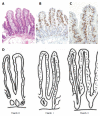Microscopic enteritis: Bucharest consensus
- PMID: 25759526
- PMCID: PMC4351208
- DOI: 10.3748/wjg.v21.i9.2593
Microscopic enteritis: Bucharest consensus
Abstract
Microscopic enteritis (ME) is an inflammatory condition of the small bowel that leads to gastrointestinal symptoms, nutrient and micronutrient deficiency. It is characterised by microscopic or sub-microscopic abnormalities such as microvillus changes and enterocytic alterations in the absence of definite macroscopic changes using standard modern endoscopy. This work recognises a need to characterize disorders with microscopic and submicroscopic features, currently regarded as functional or non-specific entities, to obtain further understanding of their clinical relevance. The consensus working party reviewed statements about the aetiology, diagnosis and symptoms associated with ME and proposes an algorithm for its investigation and treatment. Following the 5(th) International Course in Digestive Pathology in Bucharest in November 2012, an international group of 21 interested pathologists and gastroenterologists formed a working party with a view to formulating a consensus statement on ME. A five-step agreement scale (from strong agreement to strong disagreement) was used to score 21 statements, independently. There was strong agreement on all statements about ME histology (95%-100%). Statements concerning diagnosis achieved 85% to 100% agreement. A statement on the management of ME elicited agreement from the lowest rate (60%) up to 100%. The remaining two categories showed general agreement between experts on clinical presentation (75%-95%) and pathogenesis (80%-90%) of ME. There was strong agreement on the histological definition of ME. Weaker agreement on management indicates a need for further investigations, better definitions and clinical trials to produce quality guidelines for management. This ME consensus is a step toward greater recognition of a significant entity affecting symptomatic patients previously labelled as non-specific or functional enteropathy.
Keywords: Bucharest consensus; Enteropathy; Gluten; Malabsorption; Microscopic enteritis; Non-celiac gluten.
Figures


References
-
- Rustagi T, Rai M, Scholes JV. Collagenous gastroduodenitis. J Clin Gastroenterol. 2011;45:794–799. - PubMed
-
- Aziz I, Evans KE, Hopper AD, Smillie DM, Sanders DS. A prospective study into the aetiology of lymphocytic duodenosis. Aliment Pharmacol Ther. 2010;32:1392–1397. - PubMed
-
- Kakar S, Nehra V, Murray JA, Dayharsh GA, Burgart LJ. Significance of intraepithelial lymphocytosis in small bowel biopsy samples with normal mucosal architecture. Am J Gastroenterol. 2003;98:2027–2033. - PubMed
-
- Veress B, Franzén L, Bodin L, Borch K. Duodenal intraepithelial lymphocyte-count revisited. Scand J Gastroenterol. 2004;39:138–144. - PubMed
Publication types
MeSH terms
LinkOut - more resources
Full Text Sources
Other Literature Sources

